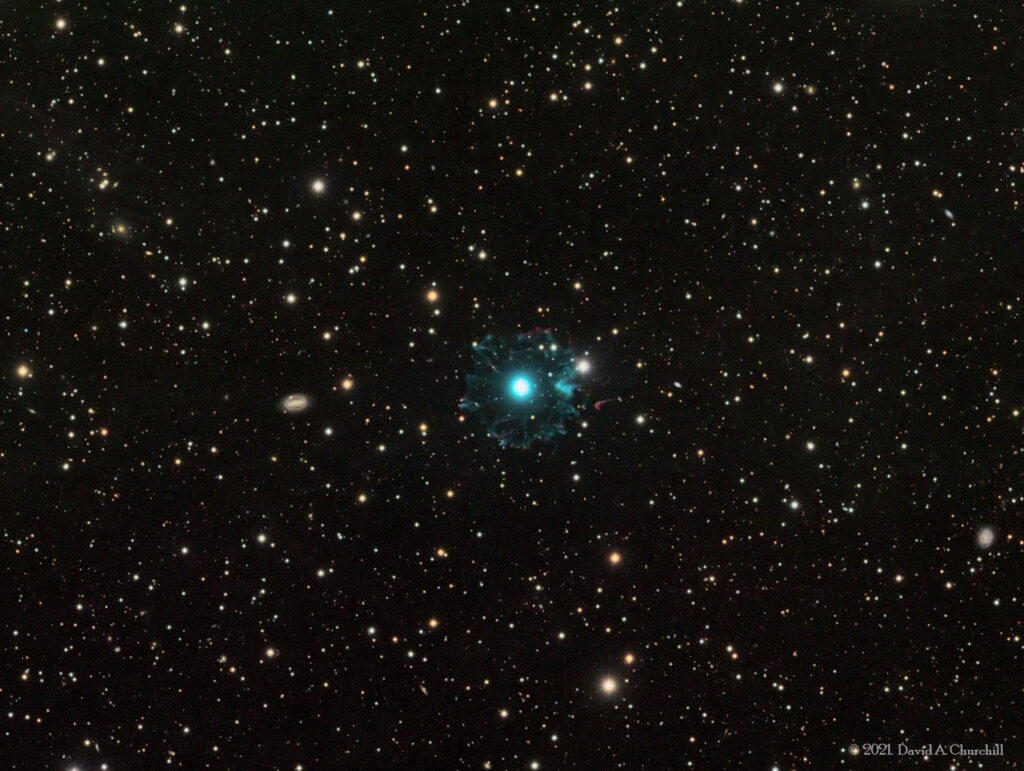Caldwell 6 (NGC 6543)
The Cat's Eye Nebula. Planetary Nebula, Draco
- Description
- Technical
- Links
The Cat’s Eye Nebula (also known as NGC 6543 and Caldwell 6) is a planetary nebula in the northern constellation of Draco, discovered by William Herschel on February 15, 1786. It was the first planetary nebula whose spectrum was investigated by the English amateur astronomer William Huggins, demonstrating that planetary nebulae were gaseous and not stellar in nature. Structurally, the object has had high-resolution images by the Hubble Space Telescope revealing knots, jets, bubbles and complex arcs, being illuminated by the central hot planetary nebula nucleus (PNN). It is a well-studied object that has been observed from radio to X-ray wavelengths.
NGC 6543 is a high northern declination deep-sky object. It has the combined magnitude of 8.1, with high surface brightness. Its small bright inner nebula subtends an average of 16.1 arcsec, with the outer prominent condensations about 25 arcsec. Deep images reveal an extended halo about 300 arcsec or 5 arcminutes across, that was once ejected by the central progenitor star during its red giant phase.
NGC 6543 is 4.4 minutes of arc from the current position of the north ecliptic pole, less than 1⁄10 of the 45 arcminutes between Polaris and the current location of the Earth’s northern axis of rotation. It is a convenient and accurate marker for the axis of rotation of the Earth’s ecliptic, around which the celestial North Pole rotates. It is also a good marker for the nearby “invariable” axis of the solar system, which is the center of the circles which every planet’s north pole, and the north pole of every planet’s orbit, make in the sky. Since motion in the sky of the ecliptic pole is very slow compared to the motion of the Earth’s north pole, its position as an ecliptic pole station marker is essentially permanent on the time-scale of human history, as opposed to the pole star, which changes every few thousand years.
Observations show the bright nebulosity has temperatures between 7000 and 9000 K, whose densities average of about 5000 particles per cubic centimetre. Its outer halo has the higher temperature around 15,000 K, but is of much lower density. Velocity of the fast stellar wind is about 1900 km/s, where spectroscopic analysis shows the current rate of mass loss averages 3.2×10−7 solar masses per year, equivalent to twenty trillion tons per second (20 Eg/s).
Surface temperature for the central PNN is about 80,000 K, being 10,000 times as luminous as the sun. Stellar classification is O7 + [WR]-type star. Calculations suggest the PNN is over one solar mass, from a theoretical initial 5 solar masses. The central Wolf–Rayet star has a radius of 0.65 R☉ (452,000 km). The Cat’s Eye Nebula, given in some sources, lies about three thousand light-years from Earth.
The Cat’s Eye was the first planetary nebula to be observed with a spectroscope by William Huggins on August 29, 1864. Huggins’ observations revealed that the nebula’s spectrum was non-continuous and made of a few bright emission lines, first indication that planetary nebulae consist of tenuous ionised gas. Spectroscopic observations at these wavelengths are used in abundance determinations, while images at these wavelengths have been used to reveal the intricate structure of the nebula.
Telescope: Astro Physics 175EDF f8.3
Mount: Astro Physics 3600GTO “El Capitan”
Camera: SBIG STT8300
Guider: Mini Borg 50 / SBIG STi
L: 51×10 mins = 510 mins, R: 24×10 mins = 240 mins, G: 24×10 mins = 240 mins, B: 30×10 mins = 300 mins
Total Imaging Time: 21h 30m
Data Imaged remotely over 9 nights during June & July 2021.
Data acquisition & Processing by David Churchill.
None

